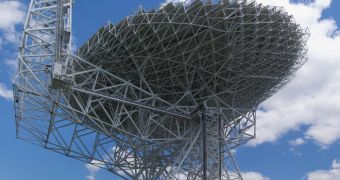A group of astronomers from the University of California in Berkeley (UCB) have just started a new investigations campaign, during which they will analyze some of the most Earth-like exoplanets identified by the NASA Kepler Telescope.
Thus far, the instrument was able to find 1,235 planetary candidates, of which more than 80 percent are expected to receive confirmation, and be classified as exoplanets. Some of these objects are more similar to Earth, whereas others are gas giant-sized hot Jupiters.
What the UCB team is planning to do is aim a powerful telescope at the most Earth-like of these potential exoplanets, and then search for signals that may be produced by an alien civilization.
This study will be conducted with the largest steerable radio observatory in the world, the Robert C. Byrd Green Bank Telescope (GBT). The Arecibo Observatory in Puerto Rico is the only radio telescope larger than the GBT, but it is built in a caldera, and pointing is achieved via Earth's rotation.
According to UCB representatives, GBT scans began on Saturday, May 8, and focused on 8 stars that may potentially harbor exoplanets. When enough data is collected on a total of 86 Earth-like planets, the team will send the information to an estimated 1 million SETI@home users.
These individuals are willing to donate some of their computers' processing power for science, and this comes in very handy for researchers who don't have the kind of money needed to rent hours on advanced, dedicated supercomputers.
“It’s not absolutely certain that all of these stars have habitable planetary systems, but they’re very good places to look for ET,” UCB graduate student Andrew Siemion.
“We’ve picked out the planets with nice temperatures – between zero and 100 degrees Celsius – because they are a lot more likely to harbor life,” veteran SETI researcher and physicist Dan Werthimer explains. He is also the chief scientist for SETI@home.
“With Arecibo, we focus on stars like our sun, hoping that they have planets around them that emit intelligent signals. But we’ve never had a list of planets like this beforem” the investigator explains.
“It’s really amazing that SETI is able to come back home to Green Bank where project Ozma, the first SETI observations, took place 51 years ago. We now have a sensitivity that was undreamed of when Frank Drake ran his experiment in 1960,” GBT scientist Ronald Maddalena explains.

 14 DAY TRIAL //
14 DAY TRIAL //